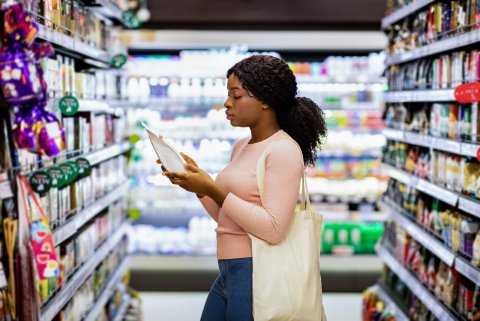Congress may still be debating how to deal with climate change, but retailers and manufacturers aren't waiting. Taking cues from customers, these businesses are embracing, big-time, eco-friendly standards and products.
While sustainable products make up less than one-fifth of all items on the market these days, they're driving one-third of all growth seen among consumer goods, ranging from skincare to milk, according to New York University's Stern Center for Sustainable Business. In fact, one in every two new consumer products brands might be considered green, or partly green.
It's not a big mystery why: Eight in ten Americans say sustainability is important to them, and almost 60 percent are willing to change their buying habits to help the planet, says the National Retail Federation.
"Consumers have turned into conscious shoppers. There is a rising recognition that climate change is real and I think for many people it is one of the top concerns," says Randi Kronthal-Sacco, senior scholar of marketing and corporate outreach at the NYU Stern Center for Sustainable Business. "There are a lot of consumers and shareholders putting pressure on companies."
While no new item you purchase will actively help the environment, buying decisions can help lessen the destructive toll. Newsweek asked sustainability experts to weigh in on how to shop, where to shop, and what to look out for when you need to buy new. Here's a green cheat sheet:

Start with a Curated List
To easily find more sustainable products, use a list organized by a multi-brand retailer. Sephora, for instance, designates some brands it carries as "Clean + Planet Positive'' if they meet certain criteria, such as having carbon-neutral operations, avoiding micro plastics, using packaging made from recycled material and allocating profits to environmental causes. Amazon, Nordstrom, Zappos, Ulta and many others all feature similar lists of brands that meet certain eco standards. Others, such as Made Trade, EarthHero, DoneGood and Credo Beauty, go a step further by exclusively carrying items that meet sustainable benchmarks.
Website Dive
To fully understand how a brand's products are more green, have a look at the sustainability or social responsibility section of the company's website. "If they're not doing the right things, it will be hard to find this," says Kathryn Kellogg, author of 101 Ways to Go Zero Waste. "You want the company to be talking proudly about sustainability and how workers are treated."
If you're still unsure? The Good on You app and Project Just website allow you to input a company's name into their database and read about its environmental impact and labor policies. Or you could just ask. "If a company does have sustainability as its north star, they will be more likely to answer your questions," says Ashlee Piper, author of Give a Sh*t: Do Good. Live Better. Save the Planet.
Review Credentials
Hundreds of different labels and certifications exist that are designed to give the impression of being eco-friendly but few carry real weight. "It's still a burgeoning field and kind of like the Wild West right now," says Piper.
The following designations, however, are independently evaluated and worth searching for according to our experts.
First, find companies touting their Fair Trade seal or their B Corp status. To be designated as Fair Trade, a business must meet standards for environmental protections, safe working conditions, and fair wages. While earning a B Corp certification means companies must "balance purpose and profits'' and demonstrate social and environmental performance.
The best-known environmental credential is the 30-year-old Energy Star program operated by the Department of Energy and Environmental Protection Agency. It evaluates the energy efficiency of appliances, electronics, computers, and lighting. For products made from timber, such as furniture, paper and toilet rolls, look for the Forest Stewardship Council label, which certifies that the trees used were sustainably harvested. And for textiles or leather items, like clothing and sofas, the OEKO-TEX designation indicates that the fabric contains no harmful chemicals, while its additional "Made in Green'' label means it's also manufactured in environmentally-friendly facilities.
The 1% for the Planet certification means the brand is giving at least 1 percent of its annual sales to environmental charities, though the label does not mean the company itself is sustainable.
Focus on Materials
"A recycling symbol just means an item theoretically can be recycled, not that your area collects it or can process it or that there are buyers out there for it," says Henry Fovargue, a partner at Boston Consulting Group. (Only a third of waste ends up recycled or composted, per the EPA.)
What to do? Buy items made from post-consumer reclaimed materials. This means they've already been recycled in some way—instead of just promising to be recycled in the future. Loop Swim, for instance, creates bathing suits from polyester fabric made out of used water bottles.
If you must buy an item made from new materials, opt for paper or glass over plastic. More than two-thirds of all paper and paperboard gets recycled in the U.S.—a third of all glass does the same. (Only about 9 percent of all plastic gets a second life, per the EPA.) For clothing or other textiles items, you'll want to check the labels for natural and biodegradable materials like wool, silk, hemp, cotton and linen as opposed to synthetic fabrics, such as polyester, acrylic or nylon.

Look for Repair or Buy-Back Policies
Buying from companies with generous warranty or repair programs helps the environment by ultimately reducing the number of items you'll need to buy in the long run. Luggage firm, Away, for example, offers a lifetime warranty that covers damage to the shell, wheels, handles, and zippers of its suitcases. And clothing maker/retailer Eileen Fisher replaces broken zippers or missing buttons on its garments for free.
Many retailers have also begun operating buy-back programs, which "help ensure items can be reused or properly recycled and are not disposed of," says Piper. IKEA, Levi's, Patagonia and REI, for instance, allow customers to sell their used items back to the store for credit so that the company can resell them. Other brands will take back items that can't be resold and reuse them in their manufacturing processes.
Buy Local...But if You Can't, Go Online
When shopping, "think how long the supply chain is before that item comes to you," says Kellogg. The further an item has to travel, the more carbon dioxide emissions and packaging waste. Purchasing items directly from small businesses or farmers that have sourced, made, or harvested ingredients locally cuts out a big chunk of that waste.
Not finding what you need from a local company? It may seem counterintuitive to shop online to be greener, but multiple studies show it's less harmful to the environment than traditional in-person shopping. This is largely because delivery trucks, unlike you and your car, are optimized for efficiency, following routes using the least amount of fuel. Also: try and bundle purchases into a single order.
Don't Get Stuck on Perfection
Sustainable products cost 29 percent more, on average, compared to their more conventional peers, the NYU Stern Center for Sustainable Business found. But, don't let that deter you from being greener.
"At the end of the day, it doesn't even have to be from the sustainable option if it is a piece you'll have forever," says Kellogg. "If you buy an item from a sustainable brand each year that could still be a net negative over buying something from a less sustainable brand that will last your lifetime."
About the writer
Kerri Anne Renzulli is personal finance journalist based in London; she's written for Money, Financial Planning magazine and CNBC.













